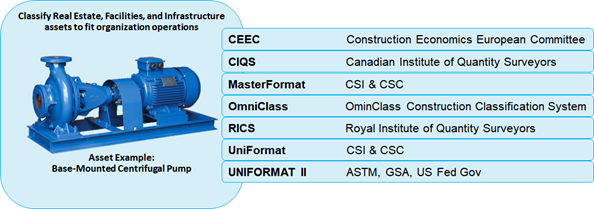
With V.24.1, users can apply up to four different classification standards to an asset, so that different stakeholders can track the asset from multiple perspectives. Users can simultaneously view all applied classifications standards for the asset.
With ARCHIBUS support for multiple asset classification standards, organizations can classify the same asset using different classification standards. This enables asset owners and responsible stakeholders to classify each asset in the format that best suits the way that stakeholder manages, tracks, and reports on the asset in each phase of the asset's lifecycle.
For example, during the design and construction phase of a project, engineers and bid managers may use Master Format or Omniclass to classify an asset. After the building project has been handed off to the building owner or operator, asset managers may use UNIFORMAT II to manage the asset during its lifecycle. Overseas managers may use local standards. This allows stakeholders in the same department or job function to communicate information about the asset using the classification code relevant to their job function.
The figure below shows some commonly used asset classification standards that organizations use to classify assets. The base-mounted centrifugal pump is one example of an asset that is actively managed using classification codes.

Asset Management / Enterprise Asset Management / Business Process Owner - Asset Manager / Define Classifications
| Copyright © 1984-2019, ARCHIBUS, Inc. All rights reserved. |